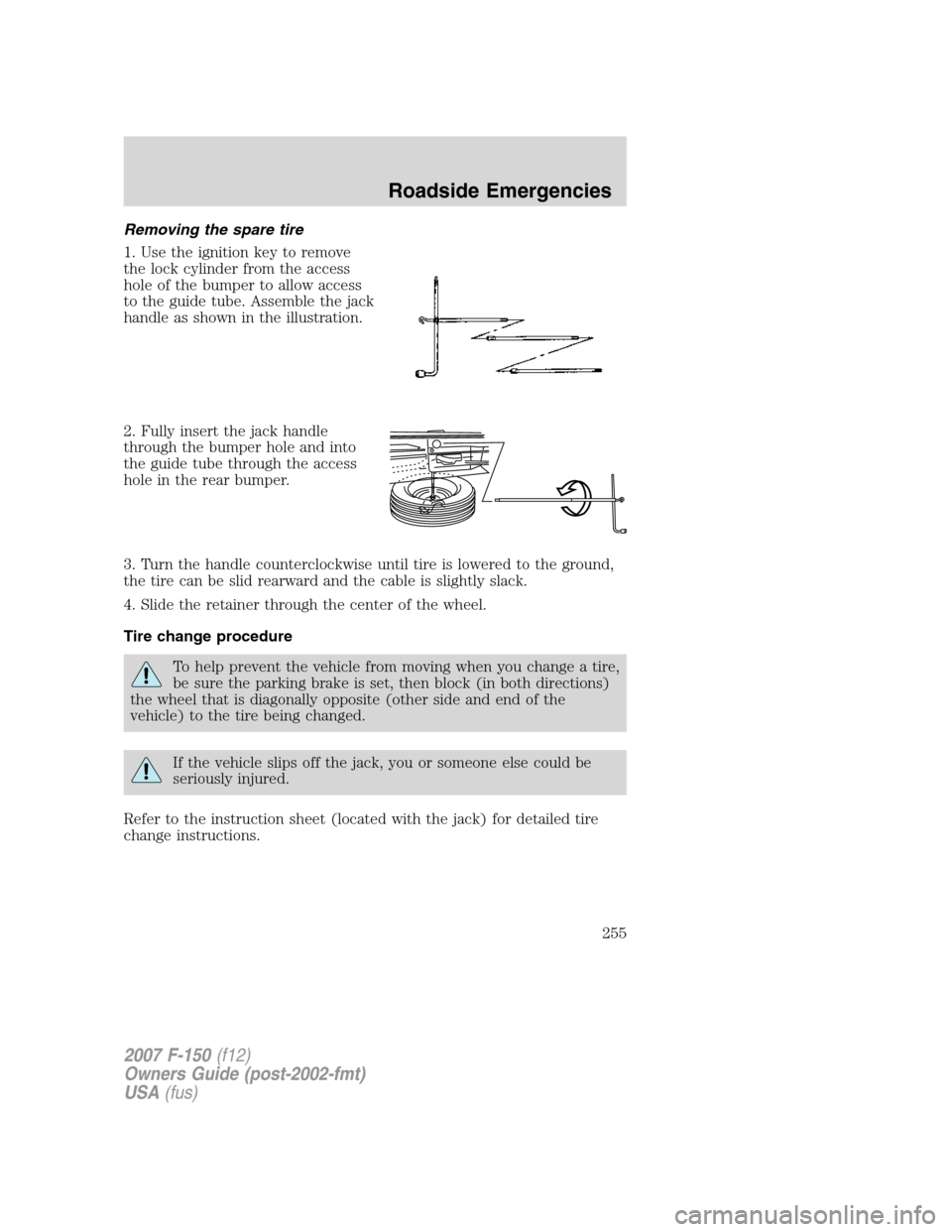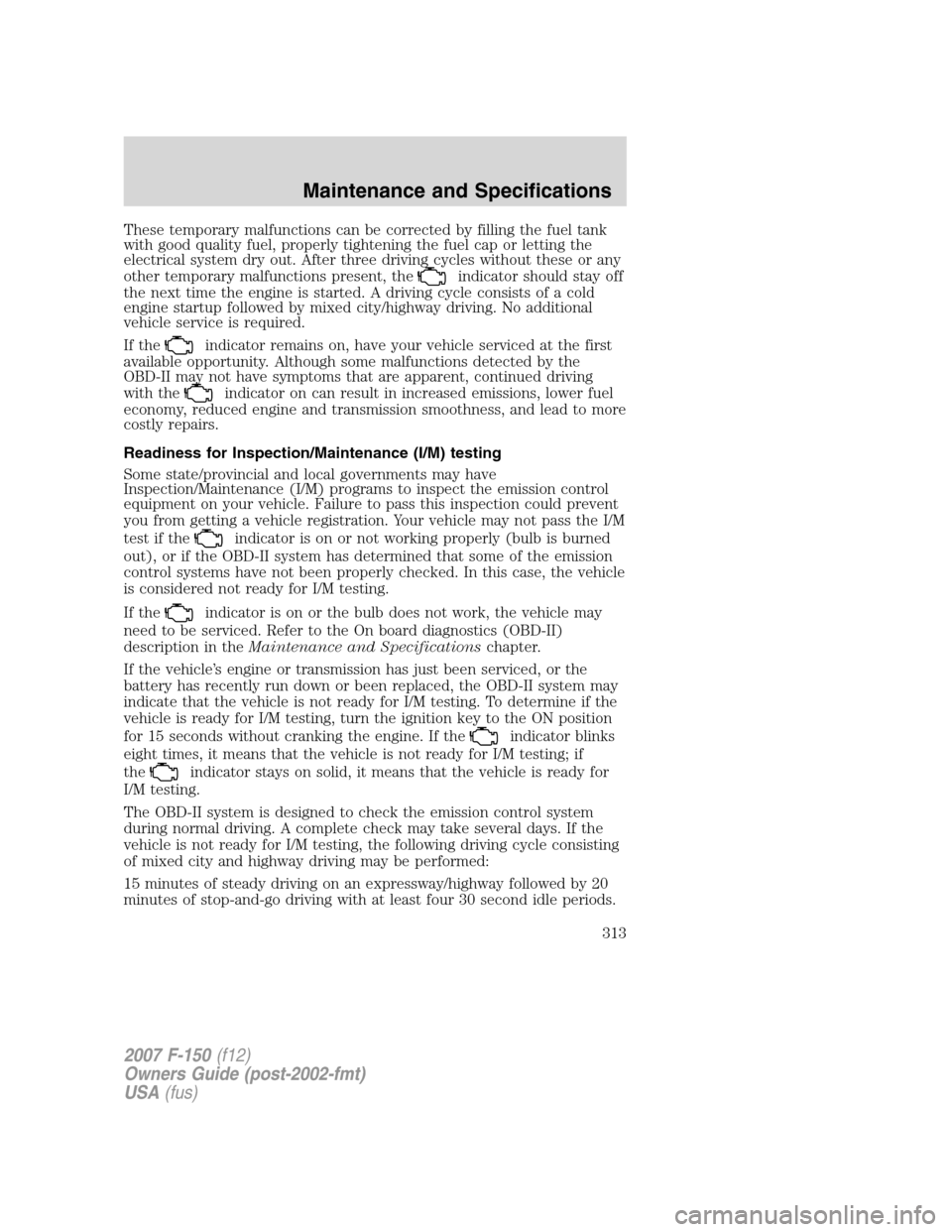2007 FORD F150 ignition
[x] Cancel search: ignitionPage 255 of 344

Removing the spare tire
1. Use the ignition key to remove
the lock cylinder from the access
hole of the bumper to allow access
to the guide tube. Assemble the jack
handle as shown in the illustration.
2. Fully insert the jack handle
through the bumper hole and into
the guide tube through the access
hole in the rear bumper.
3. Turn the handle counterclockwise until tire is lowered to the ground,
the tire can be slid rearward and the cable is slightly slack.
4. Slide the retainer through the center of the wheel.
Tire change procedure
To help prevent the vehicle from moving when you change a tire,
be sure the parking brake is set, then block (in both directions)
the wheel that is diagonally opposite (other side and end of the
vehicle) to the tire being changed.
If the vehicle slips off the jack, you or someone else could be
seriously injured.
Refer to the instruction sheet (located with the jack) for detailed tire
change instructions.
2007 F-150(f12)
Owners Guide (post-2002-fmt)
USA(fus)
Roadside Emergencies
255
Page 308 of 344

If you have run out of fuel:
•You may need to cycle the ignition from OFF to ON several times after
refueling to allow the fuel system to pump the fuel from the tank to
the engine. On restarting, cranking time will take a few seconds longer
than normal.
•Normally, adding one gallon of fuel is enough to restart the engine. If
the vehicle is out of fuel and on a steep grade, more than one gallon
may be required.
•The
indicator may come on. For more information on the “check
engine” or the “service engine soon” indicator, refer toWarning lights
and chimesin theInstrument Clusterchapter.
ESSENTIALS OF GOOD FUEL ECONOMY
Measuring techniques
Your best source of information about actual fuel economy is you, the
driver. You must gather information as accurately and consistently as
possible. Fuel expense, frequency of fill-ups or fuel gauge readings are
NOT accurate as a measure of fuel economy. We do not recommend
taking fuel economy measurements during the first 1,000 miles (1,600
km) of driving (engine break-in period). You will get a more accurate
measurement after 2,000 miles-3,000 miles (3,000 km–5,000 km).
Filling the tank
The advertised fuel capacity of the fuel tank on your vehicle is equal to
the rated refill capacity of the fuel tank as listed in theMaintenance
product specifications and capacitiessection of this chapter.
The advertised capacity is the amount of the indicated capacity and the
empty reserve combined. Indicated capacity is the difference in the
amount of fuel in a full tank and a tank when the fuel gauge indicates
empty. Empty reserve is the small amount of fuel remaining in the fuel
tank after the fuel gauge indicates empty.
The amount of usable fuel in the empty reserve varies and should
not be relied upon to increase driving range. When refueling your
vehicle after the fuel gauge indicates empty, you might not be
able to refuel the full amount of the advertised capacity of the
fuel tank due to the empty reserve still present in the tank.
For consistent results when filling the fuel tank:
•Turn the engine/ignition switch to the off position prior to refueling,
an error in the reading may result if the engine is left running.
2007 F-150(f12)
Owners Guide (post-2002-fmt)
USA(fus)
Maintenance and Specifications
308
Page 311 of 344

•Using fuel blended with alcohol may lower fuel economy.
•Fuel economy may decrease with lower temperatures during the first
8–10 miles (12–16 km) of driving.
•Driving on flat terrain offers improved fuel economy as compared to
driving on hilly terrain.
•Transmissions give their best fuel economy when operated in the top
cruise gear and with steady pressure on the gas pedal.
•Four-wheel-drive operation (if equipped) is less fuel efficient than
two-wheel-drive operation.
•Close windows for high speed driving.
EPA window sticker
Every new vehicle should have the EPA window sticker. Contact your
authorized dealer if the window sticker is not supplied with your vehicle.
The EPA window sticker should be your guide for the fuel economy
comparisons with other vehicles.
It is important to note the box in the lower left corner of the window
sticker. These numbers represent the Range of MPG (L/100 km)
expected on the vehicle under optimum conditions. Your fuel economy
may vary depending upon the method of operation and conditions.
EMISSION CONTROL SYSTEM
Your vehicle is equipped with various emission control components and a
catalytic converter which will enable your vehicle to comply with applicable
exhaust emission standards. To make sure that the catalytic converter and
other emission control components continue to work properly:
•Use only the specified fuel listed.
•Avoid running out of fuel.
•Do not turn off the ignition while your vehicle is moving, especially at
high speeds.
•Have the items listed inscheduled maintenance information
performed according to the specified schedule.
The scheduled maintenance items listed inscheduled maintenance
informationare essential to the life and performance of your vehicle
and to its emissions system.
If other than Ford, Motorcraft or Ford-authorized parts are used for
maintenance replacements or for service of components affecting
emission control, such non-Ford parts should be equivalent to genuine
Ford Motor Company parts in performance and durability.
2007 F-150(f12)
Owners Guide (post-2002-fmt)
USA(fus)
Maintenance and Specifications
311
Page 313 of 344

These temporary malfunctions can be corrected by filling the fuel tank
with good quality fuel, properly tightening the fuel cap or letting the
electrical system dry out. After three driving cycles without these or any
other temporary malfunctions present, the
indicator should stay off
the next time the engine is started. A driving cycle consists of a cold
engine startup followed by mixed city/highway driving. No additional
vehicle service is required.
If the
indicator remains on, have your vehicle serviced at the first
available opportunity. Although some malfunctions detected by the
OBD-II may not have symptoms that are apparent, continued driving
with the
indicator on can result in increased emissions, lower fuel
economy, reduced engine and transmission smoothness, and lead to more
costly repairs.
Readiness for Inspection/Maintenance (I/M) testing
Some state/provincial and local governments may have
Inspection/Maintenance (I/M) programs to inspect the emission control
equipment on your vehicle. Failure to pass this inspection could prevent
you from getting a vehicle registration. Your vehicle may not pass the I/M
test if the
indicator is on or not working properly (bulb is burned
out), or if the OBD-II system has determined that some of the emission
control systems have not been properly checked. In this case, the vehicle
is considered not ready for I/M testing.
If the
indicator is on or the bulb does not work, the vehicle may
need to be serviced. Refer to the On board diagnostics (OBD-II)
description in theMaintenance and Specificationschapter.
If the vehicle’s engine or transmission has just been serviced, or the
battery has recently run down or been replaced, the OBD-II system may
indicate that the vehicle is not ready for I/M testing. To determine if the
vehicle is ready for I/M testing, turn the ignition key to the ON position
for 15 seconds without cranking the engine. If the
indicator blinks
eight times, it means that the vehicle is not ready for I/M testing; if
the
indicator stays on solid, it means that the vehicle is ready for
I/M testing.
The OBD-II system is designed to check the emission control system
during normal driving. A complete check may take several days. If the
vehicle is not ready for I/M testing, the following driving cycle consisting
of mixed city and highway driving may be performed:
15 minutes of steady driving on an expressway/highway followed by 20
minutes of stop-and-go driving with at least four 30 second idle periods.
2007 F-150(f12)
Owners Guide (post-2002-fmt)
USA(fus)
Maintenance and Specifications
313
Page 328 of 344

ENGINE DATA
Engine 4.2L V6 engine 4.6L V8 engine 5.4L V8 engine
Cubic inches 256 281 330
Required fuel87 octane 87 octane 87 octane or
Ethanol (E85)
2
Firing order 1-4-2-5-3-6 1-3-7-2-6-5-4-8 1-3-7-2-6-5-4-8
Ignition system EDIS Coil on plug Coil on plug
Spark plug gap0.052–0.056 inch
(1.32–1.42mm)0.052–0.056 inch
(1.32–1.42mm)0.040–0.050 inch
(1.02–1.28mm)
1
Compression
ratio9.3:1 9.37:1 9.85:1
1The 5.4L 3V spark plug gap can’t be adjusted.
25.4L 3V FFV engines only.
Engine drivebelt routing
•4.2L V6 Engine
2007 F-150(f12)
Owners Guide (post-2002-fmt)
USA(fus)
Maintenance and Specifications
328
Page 336 of 344

checking and adding ..............289
dipstick ....................................289
filter, specifications ........292, 322
recommendations ...................292
refill capacities ........................324
specifications ..........................324
Exhaust fumes ..........................212
F
Fail safe cooling ........................299
Flexible Fuel Vehicle (FFV) ....301
Floor mats ...................................97
Fluid capacities .........................324
Foglamps .....................................59
Four-Wheel Drive vehicles .......227
driving off road .......................231
electronic shift ................229–230
indicator light .........................227
lever operated shift ................228
preparing to drive your
vehicle .....................................217
Fuel ............................................301
calculating fuel
economy ............................92, 308
cap ...........................................304
capacity ...................................324
choosing the right fuel ...........305
comparisons with EPA fuel
economy estimates .................311
detergent in fuel .....................306
filling your vehicle with
fuel ...........................301, 304, 308
filter, specifications ........301, 322
fuel pump shut-off switch .....243
improving fuel economy ........308
octane rating ...................306, 328
quality ......................................307
running out of fuel .................307safety information relating to
automotive fuels .....................301
Fuel - flex fuel vehicle
(FFV) .........................301, 305–306
Fuel pump shut-off switch .......243
Fuses ..................................244–245
G
Gas cap (see Fuel cap) ............304
Gas mileage
(see Fuel economy) .................308
Gauges .........................................19
H
Hazard flashers .........................243
Head restraints .................115, 119
Headlamps ...................................58
aiming ........................................60
autolamp system .......................58
bulb specifications ....................63
daytime running lights .............59
flash to pass ..............................59
high beam .................................59
replacing bulbs .........................64
turning on and off ....................58
Heating
heater only system ...................48
heating and air conditioning
system ...........................49, 51, 54
Homelink wireless control
system ..........................................83
Hood ..........................................284
How to get going ........................22
I
Ignition ...............................208, 328
2007 F-150(f12)
Owners Guide (post-2002-fmt)
USA(fus)
Index
336
Page 337 of 344

Illuminated visor mirror .............69
Infant seats
(see Safety seats) .....................153
Inspection/maintenance (I/M)
testing ........................................313
Instrument panel
cleaning ...................................277
cluster ........................................12
lighting up panel and
interior .......................................60
J
Jack ............................................252
positioning ...............................252
storage .....................................252
Jump-starting your vehicle ......259
K
Keyless entry system ...............110
autolock ...................................101
keypad .....................................110
locking and unlocking doors ..111
programming entry code .......111
Keys ...................................101, 113
positions of the ignition .........208
L
Lamps
autolamp system .......................58
bulb replacement
specifications chart ..................63
daytime running light ...............59
fog lamps ...................................59
headlamps .................................58
headlamps, flash to pass ..........59
instrument panel, dimming .....60
interior lamps .....................62–63
replacing bulbs ...................64, 67Lane change indicator
(see Turn signal) ........................61
Lights, warning and indicator ....12
anti-lock brakes (ABS) ..........213
Load limits .................................188
Loading instructions .................194
Locks
autolock ...................................101
childproof ................................103
doors ........................................101
Lubricant specifications ...........324
Lug nuts ....................................259
Lumbar support, seats .............117
M
Manual transmission .................223
reverse .....................................225
Message center ...........................89
english/metric button ...............93
system check button ................93
warning messages .....................94
Mirrors .........................................77
automatic dimming rearview
mirror ........................................76
fold away ...................................77
heated ........................................78
programmable memory ..........106
side view mirrors (power) .......77
signal .........................................78
Moon roof ....................................82
Motorcraft parts ........281, 301, 322
N
Navigation system .......................47
O
Octane rating ............................306
2007 F-150(f12)
Owners Guide (post-2002-fmt)
USA(fus)
Index
337